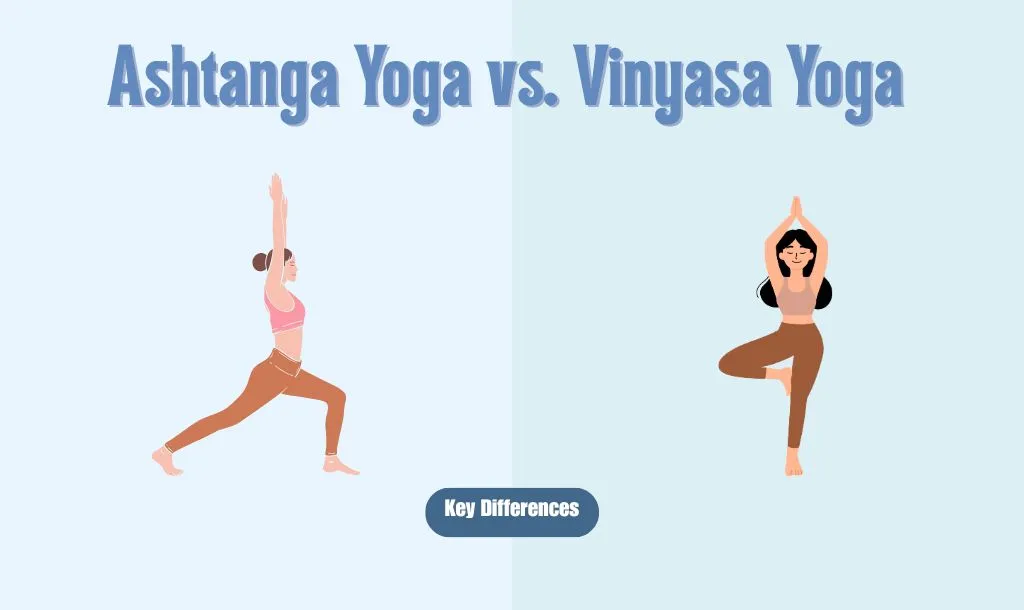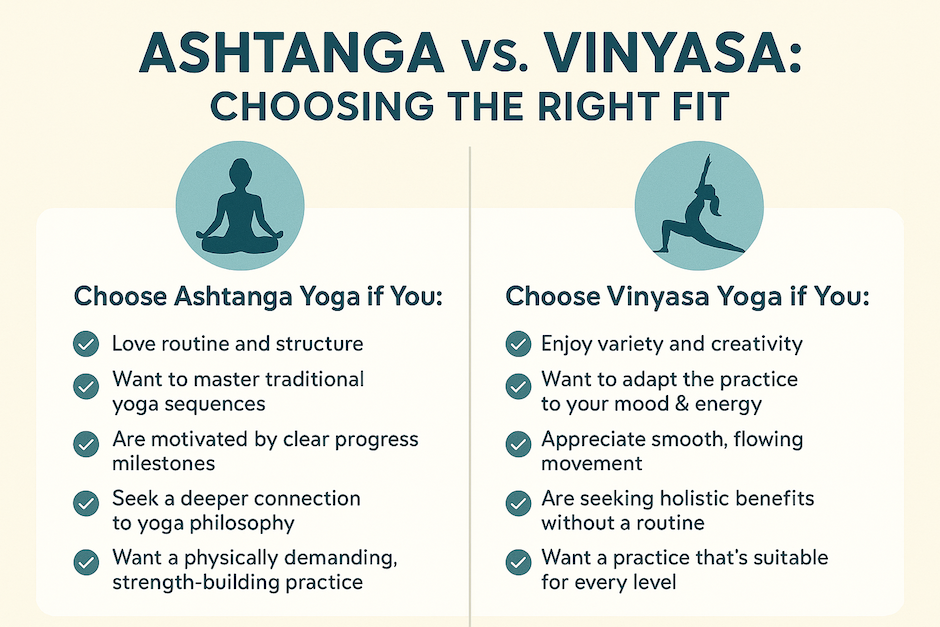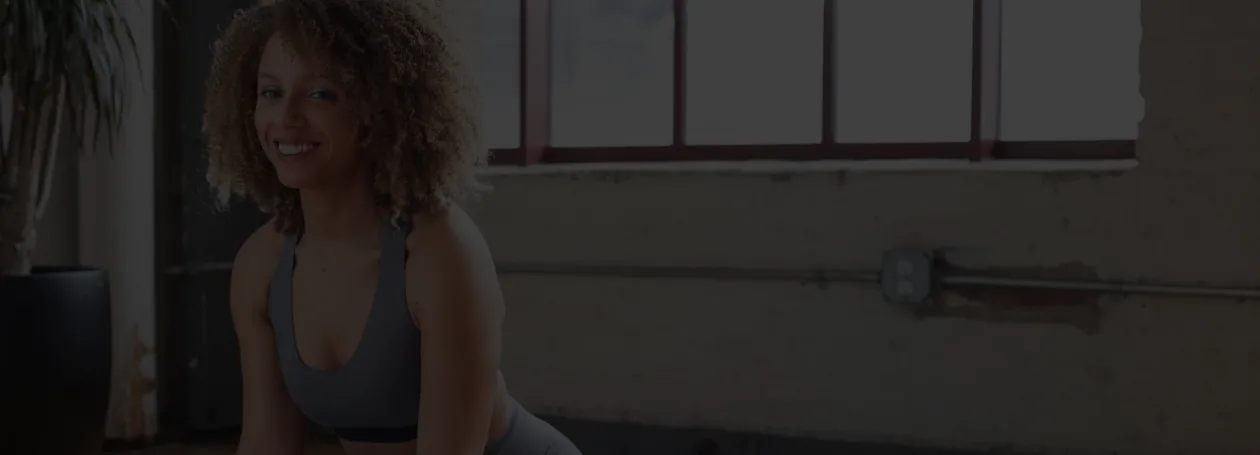

Out of the many yoga styles available, choosing the right fit for yourself can feel overwhelming, especially if you’re just starting out. Ashtanga vs. Vinyasa yoga represents one of the most common decisions when it comes to choosing one. While both build strength and mindfulness, Ashtanga follows fixed sequences rooted in tradition, while Vinyasa offers creative flows that vary each class.
When it comes to Ashtanga vs. Vinyasa Yoga, understanding a few key differences—like structure, pace, philosophy, and physical demands—can help you choose. This guide breaks it all down so you can decide which style aligns best with your fitness level, goals, and lifestyle.
Read on for a clear and detailed comparison to help you decide which style is the perfect fit for your yoga journey.
If you’re new to yoga and need expert guidance to practice safely and effectively, book a free 1-on-1 session with a coach today!
Ashtanga Yoga is a traditional, structured style of yoga that follows a specific sequence of postures linked by breath and movement. Sujit Tiwari, a certified Ashtanga Yoga coach at MyYogaTeacher, says, “The combination of poses, breathwork, and meditation in Ashtanga Yoga helps increase flexibility, strength, stamina, breathing quality, and mental clarity, providing holistic benefits to beginners and intermediate practitioners alike.”
Rooted in the teachings of Sri K. Pattabhi Jois, this method emphasizes discipline, consistency, and internal focus. In an Ashtanga practice, students move through a set series of poses—beginning with the Primary Series—in the same order every time. Each posture is connected by transitional movements and guided by Ujjayi breath, drishti (gaze point), and bandhas (energy locks), forming a complete system known as the Tristhana method.
Ashtanga is highly structured and progresses in stages. You only advance to the next posture or series once you’ve mastered the previous one, making this an ideal practice for those who crave routine, measurable progress, and a deep connection to traditional yoga philosophy.
To understand Ashtanga Yoga more deeply, read this detailed article.
Ashtanga is a great fit if you:
Want to experience an Ashtanga Yoga practice? Book this group class on Ashtanga Yoga today!
Pamela Bentley, a certified Vinyasa Yoga coach at MyYogaTeacher, says, “In Vinyasa, the idea is to glide from one pose to the next seamlessly, using your breath to guide your physical movements.”
This makes Vinyasa a dynamic and flowing sequence of poses. Each transition between postures is intentional and guided by inhalation or exhalation, resulting in what’s commonly referred to as a “flow.”
Vinyasa is unstructured and highly creative—no two classes are the same. There are unique sequences for each session, keeping the practice fresh and engaging. You can expect to move at a moderate to fast pace, with a continuous rhythm that builds heat, strength, and flexibility.
This style is ideal for those who enjoy variety, guided instruction, and dynamic movement.
Vinyasa is ideal for you if you:
Explore the differences between Hatha and Vinyasa Yoga here!
Before we jump into the detailed differences between Ashtanga and Vinyasa yoga, here is a quick comparison table to summarize the two styles:
With the basics covered, let’s dive deeper into how Ashtanga and Vinyasa yoga differ in practice, pace, and philosophy.

Still confused between Ashtanga and Vinyasa yoga? Here’s a simple breakdown to guide your decision:
Want to get started with Ashtanga yoga? Learn about the Ashtanga Yoga Primary Series here!
Experience the benefits of Vinyasa Yoga first-hand. Join this group class on Finding Your Flow in Vinyasa Yoga today!
Absolutely! Many yogis enjoy the discipline of Ashtanga while also appreciating the flow of Vinyasa.
Here’s a sample routine to balance structure and flow of Ashtanga and Vinyasa, respectively:
This flexible plan allows you to experience the benefits of yoga styles while avoiding burnout and keeping your practice fresh.
If you don’t know how to get started, our expert coaches are here to guide you! Book a free 1-on-1 session today.
Whether you’re drawn to the structured discipline of Ashtanga or the creative flow of Vinyasa, the key to a successful yoga journey is starting with proper guidance.
At MyYogaTeacher, you’ll learn from certified Indian instructors who specialize in both styles, helping you build a safe, enjoyable, and transformative practice.
Starting Ashtanga without guidance can be overwhelming, especially with its fixed and rigid sequences. Here’s how to make it easier:
Vinyasa offers flexibility, but proper technique is essential to avoid injuries.
Book a 1-on-1 session with yoga coaches well-versed in Ashtanga and Vinyasa Yoga styles for an authentic and safe experience!
The main difference is structure: Ashtanga follows the same sequence every time, while Vinyasa creates new sequences each class. Ashtanga emphasizes discipline and tradition, while Vinyasa focuses on creativity and flow.
Ashtanga is generally more physically demanding due to its fixed, vigorous sequences and focus on strength, flexibility, and stamina. On the other hand, Vinyasa varies by class and the instructor. It can be gentle, moderate, or intense, making it more adaptable for different fitness levels.
Yes! Beginners can absolutely start Ashtanga yoga with proper guidance. Many students begin with just Sun Salutations and basic poses, gradually adding more as they build strength and flexibility. Starting with expert-led classes ensures safe and steady progress.
Yes, Vinyasa yoga can support weight loss, especially power vinyasa classes that maintain a brisk pace and build heat.
If you love routine, structure, and clear progress milestones, Ashtanga may suit you better. If you prefer variety, creativity, and guided instruction, Vinyasa is the way to go. Many practitioners also enjoy mixing both styles based on their weekly goals and energy levels.

Receive personalized guidance tailored to your unique fitness goals, live with a dedicated coach—no credit card required.